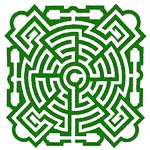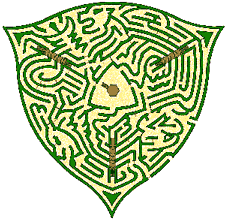
A simply-connected maze design with limited choice of paths, planted at Krenkerup,
Denmark, in 1877.

The hedge maze at Chevening House, England, c.1820, was designed to provide a more complex puzzle and thwart the "hand-on-wall" rule for solving mazes.

A modern maze with interactive features at Drielandenpunt near Vaals in the Netherlands, (© Adrian Fisher).
© 2004-2024 The Labyrinth Society & Veriditas. All Rights Reserved.
Lorem ipsum dolor sit amet, consectetur adipiscing elit. Ut elit tellus, luctus nec ullamcorper mattis, pulvinar dapibus leo.